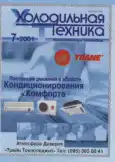Application of absorption chillers in air conditioning systems
- Authors: Kokorin O.Y.1, Kronfeld Y.G.2, Levin I.E.3
-
Affiliations:
- MGSU
- CJSC "Venta"
- "Train Technologies"
- Issue: Vol 90, No 7 (2001)
- Pages: 21-23
- Section: Articles
- URL: https://bakhtiniada.ru/0023-124X/article/view/104512
- DOI: https://doi.org/10.17816/RF104512
- ID: 104512
Cite item
Full Text
Abstract
At enterprises in many industries, technological processes are accompanied by thermal emissions in the form of steam, condensate and hot water with temperatures up to 80 ° C. In the cold season, such emissions can be used to supply heating and ventilation systems, as is done at some facilities. However, in In most cases, heat is discharged into the atmosphere.The result is environmental pollution, as well as condensation of the vapor-air mixture on the surface of the walls of buildings, which leads to their destruction.Unfortunately, such environmentally unacceptable emissions occur at confectionery factories located in the center of Moscow[ *]. However, many technological processes need cold, and sometimes both cold and heat at the same time. It is most rational to use thermal emissions to generate cold. This process can be implemented using modern absorption refrigeration machines. Such machines are manufactured by TRANE Corporation - one of the world's leading in this direction. The first absorption chiller built by TRANE had a cooling capacity of 200 kW. A long experience in design, research and operation formed the basis for the creation of a wide range of absorption lithium bromide refrigerating machines with a nominal cooling capacity from 390 to 6000 kW.
Keywords
Full Text
##article.viewOnOriginalSite##About the authors
O. Ya. Kokorin
MGSU
Author for correspondence.
Email: info@eco-vector.com
Doctor of Engineering Sciences, Prof.
Russian FederationYa. G. Kronfeld
CJSC "Venta"
Email: info@eco-vector.com
Russian Federation
I. E. Levin
"Train Technologies"
Email: info@eco-vector.com
Russian Federation
References
Supplementary files









